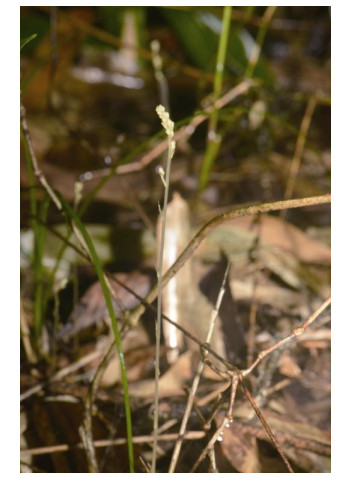2. 中国科学院东南亚生物多样性研究中心, 叶津, 比都, 缅甸;
3. 白雪山国家公园管理局, 葡萄, 克钦邦, 缅甸
2. Southeast Asia Biodiversity Research Institute, Chinese Academy of Sciences, Yezin, Nay Pyi Taw 05282, Myanmar;
3. Hkakarborazi Natural Park, Putao, Kachin State, Myanmar
The monocot family Petrosaviaceae consists of approximate two genera and ca. four species, and is widespread in tropical and subtropical regions in Asia[1-3]. Petrosaviaceae is characterized by achlorophyllous plants, reduced leaves scalelike, spiral along the stem, flowers white and actinomorphic, stamens 6, 3 carpels connate for 1/4-1/2 their length, fruit a capsule, follicle-like[1-4].
During our botanical survey in northern Myanmar, Petrosavia sakura, a species representing a new familial and order record of flora of Myanmar (see references [5, 6]), was discovered and described below.
Petrosavia sakuraii (Makino) J. J. Sm. ex Steenis, Trop. Nat. 23: 52. 1934.
Miyoshia sakuraii Makino, Bot. Mag. (Tokyo) 17: 145. 1903.
Type: Japan. Mino, foot of Mt. Ena, shady forests, 27 Jul. 1903, H. Sakurai s.n (TI).
Mycoheterotrophic plants, herbs, whitish pale yellow, 7-15 cm tall, glabrous. Rhizome ca. 2 mm thick, enclosed by dense bracts. Stems slender, erect, 1 or 2 arising from rhizome. Leaves reduced and scale-like, rather lax, usually 1-2 cm apart, spiral along the stem, narrowly to broadly ovate, acuminate, 2-5 mm long, membranous, 1-veined. Inflorescence a raceme, more or less corymbose, 2-10 cm long, up to more than 10-flowered; bracts lanceolate to ovate, 2-5 mm, slightly shorter than pedicel. Pedicel 3-7 mm long. Flowers very small. Tepals (perianth) adnate for ca. 1/3 its length to ovary, persistent; outer segments triangular, inner segments ovate-deltoid; segments 1-veined, outer ones 0.8 mm×ca. 1 mm, inner ones 2 mm×ca. 2 mm. Stamens 6, ca. 1 mm long; anthers ovate. Ovary broadly ovoid, 3-partite. Capsule ca. 3 mm×3 mm. Fl. June-Aug., fr. Oct. 2n=60.
Habitat: Under humid montane evergreen broad- leaved forest, 2 200 m.
Distribution: China, Japan, and Myanmar (new record).
Flowering Period: June to Aug.
Specimens examined. Myanmar. Kachin State, Putao County, June 17, 2016, Ziyardam, Jin X. H., Wang R. J. & Chen Y. S. PT-2277 (PE).
Petrosavia sakuraii is a rare but widespread species in montane regions of subtropical and tropical Asia[1, 3]. It is readily distinguished from its Asian relatives by scalelike leaves on stem usually 1-2 cm apart; inflorescence a raceme, more or less corymbose (Fig. 1), fertile bracts slightly shorter than pedicel, and tepals adnate for ca. 1/3 its length to ovary[1, 3, 7].

|
Fig. 1 Petrosavia sakuraii (Makino) J. J. Sm. ex Steenis (Photographed by Xiaohua JIN) |
| [1] | REMIZOWA M V, NURALIEV M S, AVERYANOV L V, et al. A revision of the family Petrosaviaceae in Vietnam[J]. Nord J Bot, 2017, 35(3): 262-271. DOI:10.1111/njb.01480 |
| [2] | TOBE H, TAKAHASHI H. Embryology of Petrosavia (Petrosaviaceae, Petrosaviales):Evidence for the distinctness of the family from other monocots[J]. J Plant Res, 2009, 122(6): 597-610. DOI:10.1007/s10265-009-0259-z |
| [3] | CAMERON K M, CHASE M W, RUDALL P J. Recircumscription of the monocotyledonous family Petrosaviaceae to include Japonolirion[J]. Brittonia, 2003, 55(3): 214-225. DOI:10.1663/0007-196X(2003)055[0214:ROTMFP]2.0.CO;2 |
| [4] | TOBE H. Embryology of Japonolirion (Petrosaviaceae, Petrosaviales):A comparison with other monocots[J]. J Plant Res, 2008, 121(4): 407-416. DOI:10.1007/s10265-008-0168-6 |
| [5] | KRESS W, DEFILIPPS R, FARR E, et al. A checklist of the trees, shrubs, herbs and climbers of Myanmar (Revised from the original works by J. H. Lace and H. G. Hundley)[J]. Contrib US Nation Herb, 2003, 45: 1-590. |
| [6] | The Angiosperm Phylogeny Group. An update of the Angiosperm Phylogeny Group classification for the orders and families of flowering plants:APG Ⅳ. Bot[J]. J Linn Soc, 2015, 181: 1-20. |
| [7] | CHEN S C, TAMURA M N. Liliaceae[M]//WU Z Y, RAVEN P H. Flora of China, Vol. 24. Beijing: Science Press & St. Louis: Missouri Botanical Garden Press, 2000: 73-263. |
 2018, Vol. 26
2018, Vol. 26


